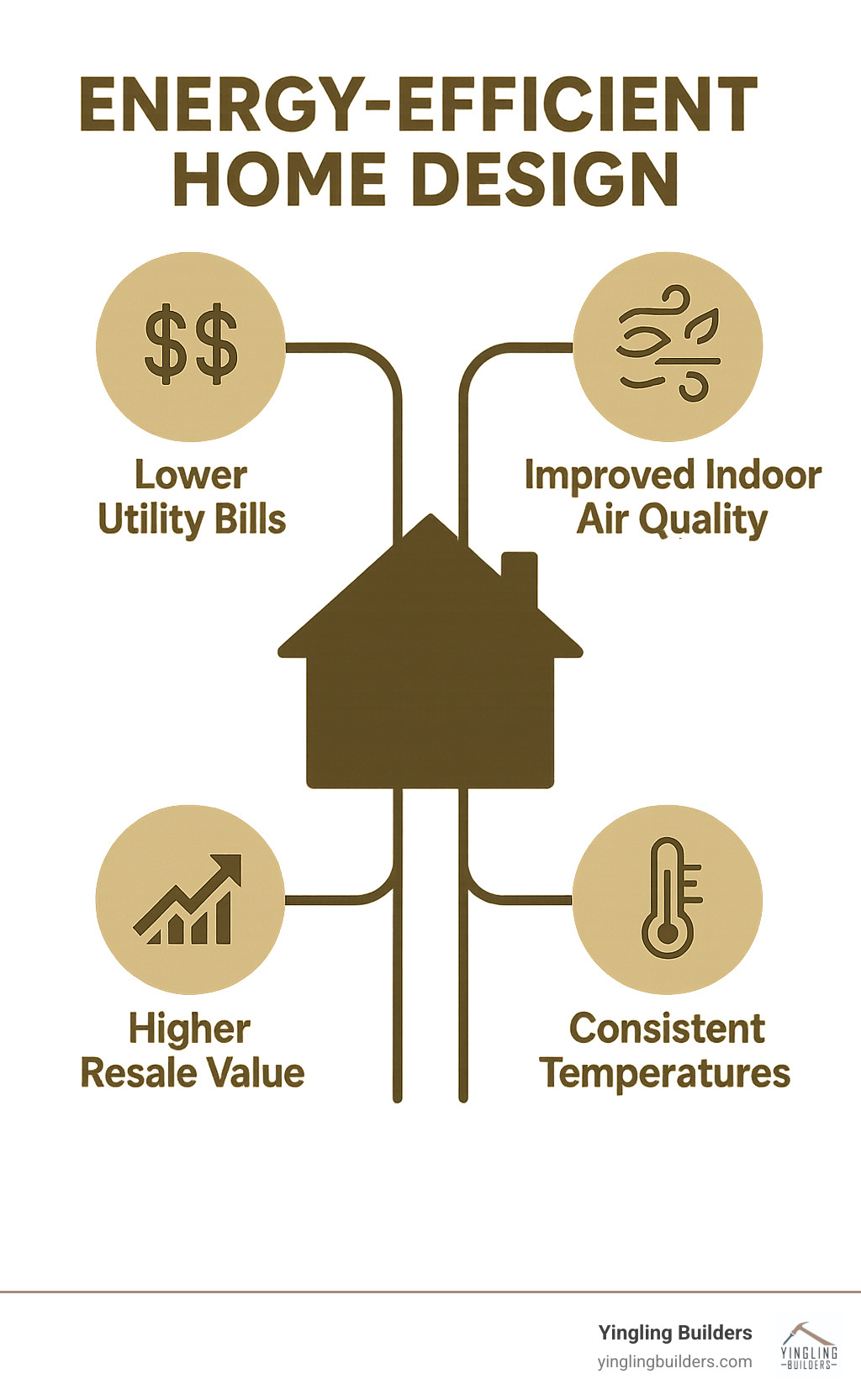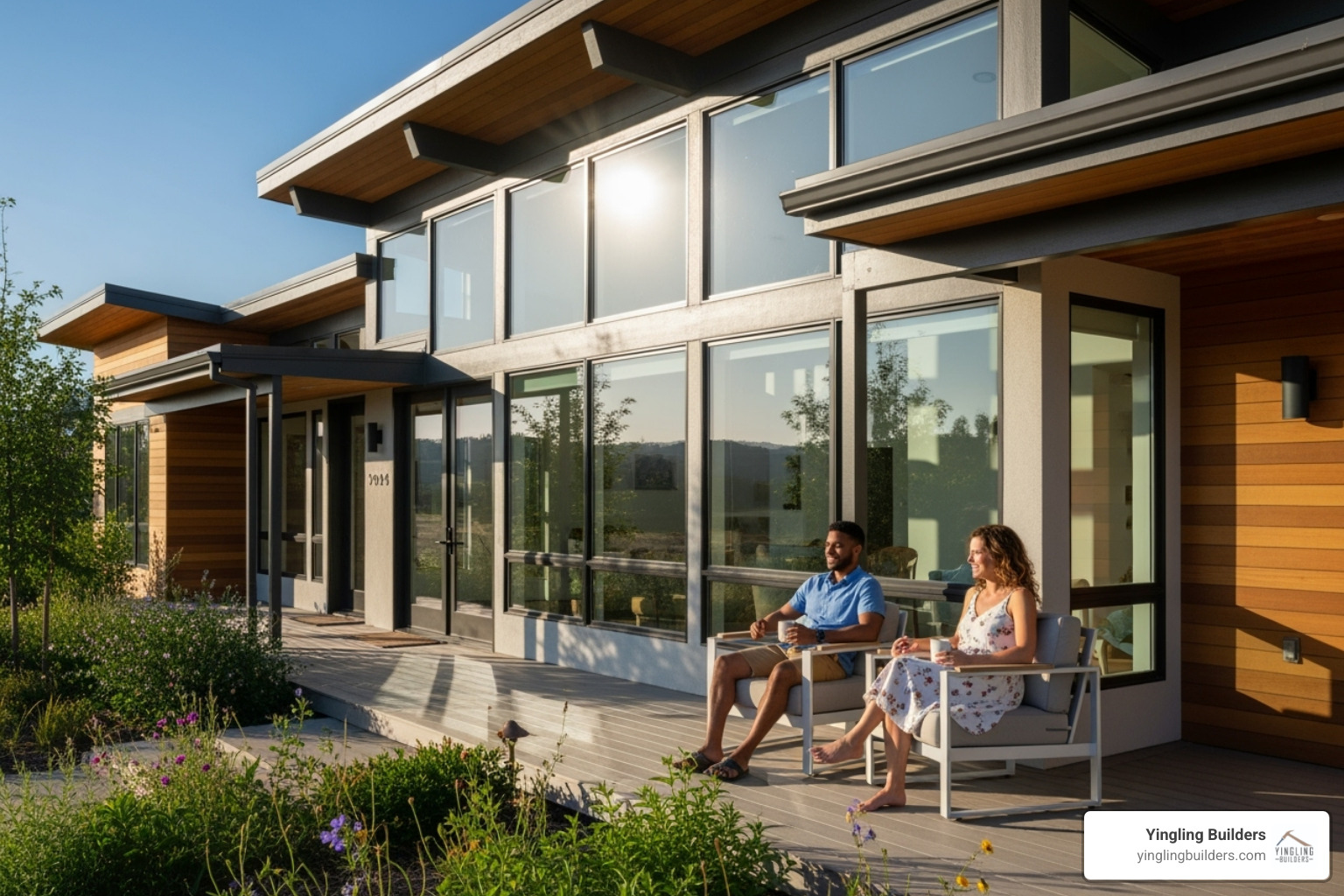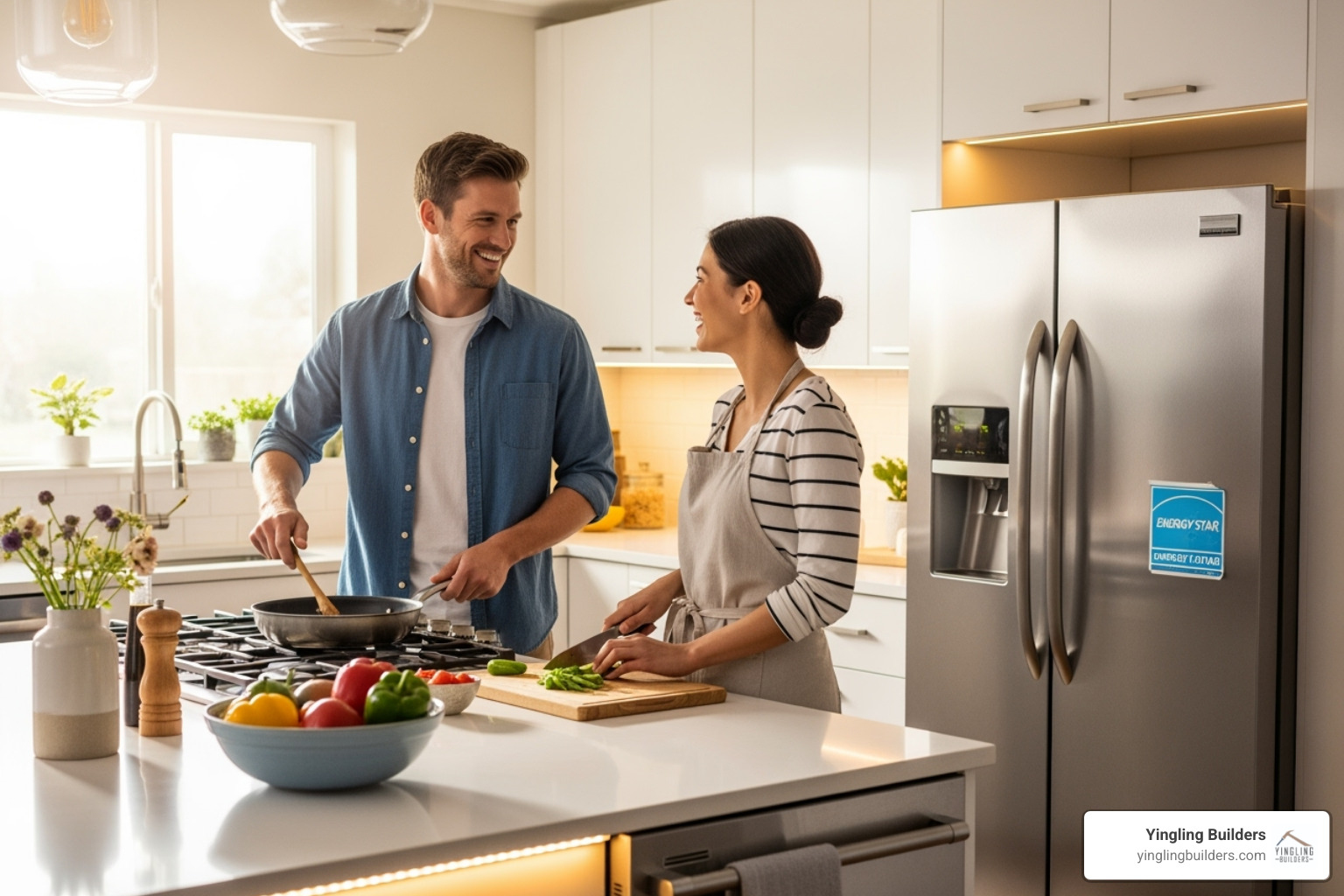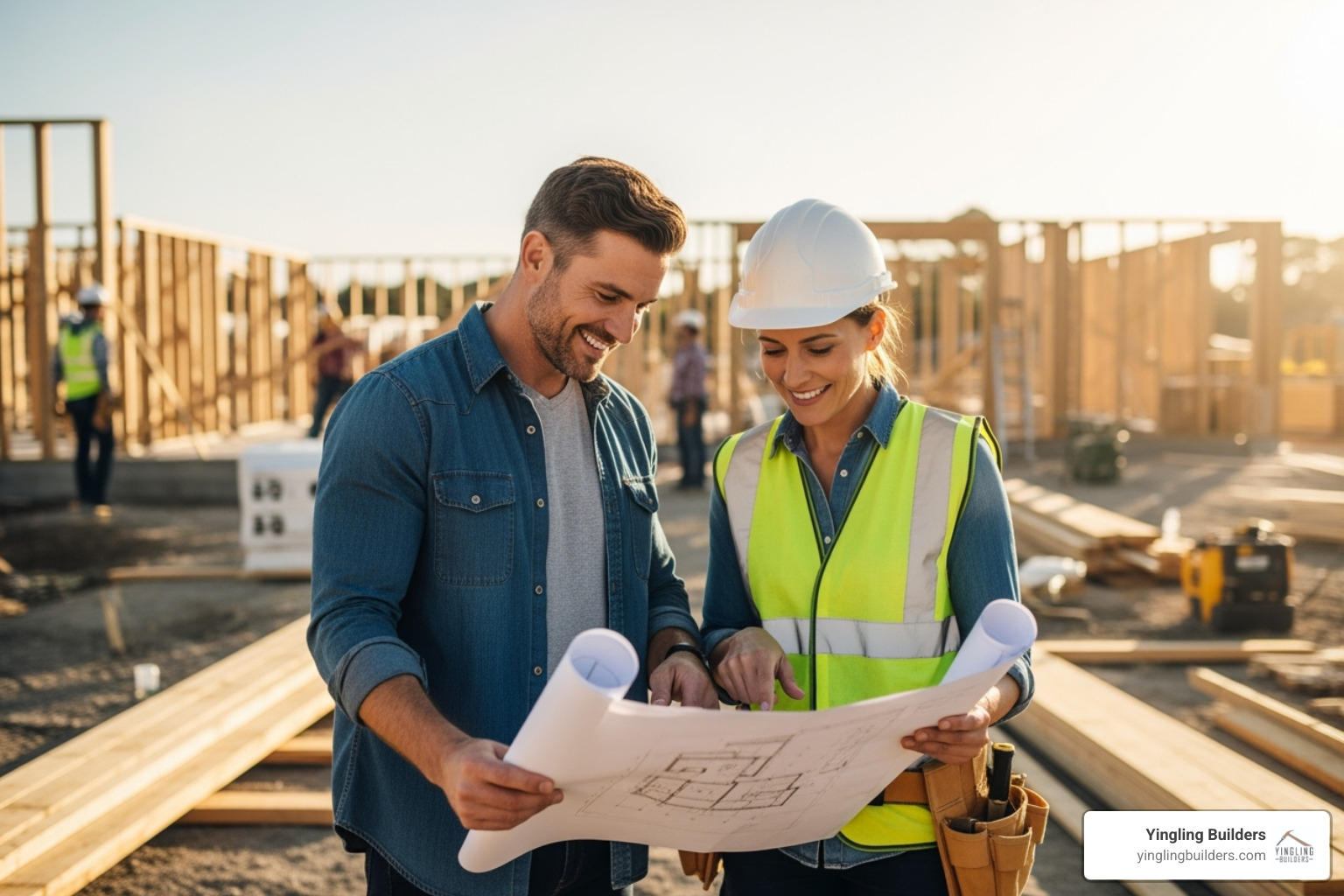Why Energy Efficient Home Design Transforms Your Living Experience
Energy efficient home design creates homes that use less energy while providing superior comfort, health benefits, and long-term cost savings. The core principles include:
Key Components of Energy Efficient Design:
- Whole-house systems approach – integrating all building components to work together
- High-performance thermal envelope – superior insulation and airtight construction
- Controlled ventilation – fresh air without energy waste
- Strategic window placement – maximizing natural light while minimizing heat loss
- Energy-efficient appliances – high-performance systems and equipment
- Smart building orientation – working with your site’s natural conditions
The benefits are immediate and lasting. Research shows that good air sealing alone can significantly reduce utility costs compared to conventional homes. Energy-efficient buildings also provide naturally warmer, healthier, and more comfortable living spaces with consistent temperatures year-round.
Modern energy-efficient homes aren’t just about saving money—they’re about creating spaces that improve your quality of life. With better indoor air quality, reduced noise, and improved comfort, these homes improve your daily living experience.
The whole-house systems approach ensures every component—from your foundation insulation to your roof materials—works together for maximum efficiency. This integrated thinking considers occupant behavior, site conditions, and climate to create homes that perform beautifully for decades.
I’m Seth Yingling. With over 15 years in construction, I’ve seen how energy efficient home design transforms comfort and operating costs. At Yingling Builders, we specialize in high-performance construction, helping families in West Central Illinois build homes that work smarter, not harder.

The Blueprint for Efficiency: A Whole-House Systems Approach
When we talk about energy efficient home design, we mean more than just efficient appliances or extra insulation. We’re talking about a fundamental shift in construction: the whole-house systems approach. This means considering every variable that affects energy use from the very beginning.
Imagine your home as a living, breathing entity. Every part is connected, and a change in one area can impact another. For instance, if we super-insulate your walls but neglect air sealing, those expensive insulation efforts might literally go out the window! Our approach considers occupant behavior, site conditions, and local climate to create an optimized living space that works in harmony with its environment for maximum comfort and minimal energy waste.
Creating a High-Performance Thermal Envelope
At the heart of any energy efficient home design is the thermal envelope. This is the shell of your home – the walls, roof, foundation, windows, and doors – that separates the conditioned indoor space from the outdoors. Our goal is to make this envelope as robust as possible to minimize heat transfer and keep your indoor temperatures stable.
We focus on a high R-value (a measure of resistance to heat flow), aiming for levels that far exceed typical standards. This involves continuous insulation and advanced framing techniques to maximize thermal performance.
Windows are crucial components of the thermal envelope, as a typical home can lose a significant amount of its heat through them. That’s why we prioritize high-performance windows, which can lead to substantial savings on annual household energy bills by minimizing heat loss in winter and heat gain in summer.
Airtight construction is also paramount. We seal every crack and crevice to prevent air leakage, which can dramatically reduce utility costs compared to similar homes. A blower door test measures the home’s airtightness to ensure it meets stringent performance standards, effectively wrapping your home in a perfectly sealed thermal blanket.
More info about our custom home design process
The Importance of Air Sealing and Ventilation
While a tightly sealed home is great for energy efficiency, it requires controlled ventilation for fresh air. We integrate sophisticated mechanical ventilation systems that bring in fresh, filtered outdoor air while exhausting stale indoor air. This is vital for good indoor air quality, especially since people spend the vast majority of their time indoors.
Air sealing involves carefully caulking cracks between stationary components like window frames and using weatherstripping for moving parts like doors. This reduces drafts, prevents moisture issues, and contributes to a stable indoor environment.
An airtight home without proper ventilation can lead to moisture buildup and poor air quality. That’s why we employ heat-recovery ventilators (HRVs) or energy-recovery ventilators (ERVs), which salvage a high percentage of the energy from the stale exhaust air. This gives you fresh air without wasting your heating or cooling budget.
This balance of air sealing and controlled ventilation is key to a healthy, energy-efficient indoor environment, preventing issues like mold and pollutants. It’s how we ensure your home is not just efficient, but a truly healthy place to live.
Passive and Ultra-Efficient: The Future of Home Design

The future of home building isn’t about gadgets; it’s about working smarter with nature. Energy efficient home design now accepts passive principles—using the sun’s energy, natural cooling, and smart building science to create homes that require minimal energy.
Instead of relying on expensive equipment to heat and cool a home, we design homes that are naturally comfortable. This approach centers on superinsulation, thermal bridge-free construction to eliminate heat loss spots, and precise building techniques for an incredibly airtight home.
The result is a home that’s net-zero energy ready from day one. When your house needs so little energy, adding on-site renewable energy options like solar panels becomes practical and affordable. You’re essentially building a home that can power itself.
Core Principles of Passive Solar Home Design
Passive solar design uses the sun as a natural heating and cooling assistant. The key is working with your site selection and the sun’s movement throughout the seasons.
Window placement is an art form. We strategically position large, south-facing windows to capture solar heat gain during winter when the sun is low in the sky. It’s free heating that feels amazing.
Cleverly, we also prevent summer overheating with thoughtful shading strategies. Precisely designed overhangs block the high summer sun but allow the lower winter sun to enter, providing automatic seasonal climate control built into your home’s architecture.
Thermal mass materials like concrete floors act as natural heat batteries, absorbing warmth on sunny days and releasing it at night. Meanwhile, natural cooling techniques use cross-breezes and the stack effect to pull hot air up and out while drawing in cooler air.
Achieving Net-Zero with Passive Design
Passive design is your fastest route to a net-zero energy home. By dramatically reducing energy demand with passive principles, the home’s needs become so small that renewable sources can easily cover them.
This allows for right-sized HVAC systems that are much smaller and more efficient than what conventional homes require—saving on equipment costs and improving performance.
Solar panel integration becomes simple. Instead of a massive solar array, a modest system can often meet all your needs. You’re not just building a home; you’re creating your own personal power plant.
Passive homes maintain incredibly stable temperatures, eliminate drafts, and feel pleasant year-round. Combining ultra-low energy needs with clean, renewable generation creates a home that’s smart for your wallet and the planet.
Key Elements of Energy Efficient Home Design
Beyond foundational principles, specific elements contribute to an energy efficient home design. These advanced construction techniques, smart material choices, and high-performance systems work together to make your life more comfortable and affordable.

Advanced Construction and Sustainable Materials
The structure of your home is where efficiency begins. We use advanced methods to create superior thermal performance that lasts for decades.
- Advanced framing techniques (Optimum Value Engineering) optimize lumber use, creating more space for insulation. This improves thermal performance and reduces waste.
- Structural Insulated Panels (SIPs) are prefabricated panels with a foam core, creating incredibly airtight and well-insulated walls with faster construction times.
- Insulating Concrete Forms (ICFs) are foam forms filled with concrete, resulting in walls with exceptional thermal mass, sound dampening, and durability.
- Cool roofs reflect sunlight to keep homes cooler and reduce A/C load, especially in warmer climates.
- Sustainable flooring and low-VOC materials (paints, cabinetry) improve indoor air quality and support your family’s wellness.
More info about our construction process
High-Performance Systems and Appliances
A well-built home needs efficient systems to manage daily energy use and keep utility bills low.
- High-efficiency HVAC systems: Because the home’s heating and cooling loads are so low, we can install smaller, right-sized systems that use less energy while maintaining perfect comfort.
- Tankless water heaters: These heat water on demand, eliminating the standby energy loss of a traditional tank and providing endless hot water.
- High-efficiency appliances: Choosing certified energy-saving appliances is your guide to real savings on everything from washers to windows, which can significantly reduce energy bills.
- LED lighting: LEDs use significantly less energy and last much longer than traditional bulbs.
- Smart thermostats: These learn your routines and adjust temperatures automatically, helping to save on heating and cooling costs annually.
- Water-conserving fixtures: These faucets, showerheads, and toilets reduce water use without sacrificing performance.
Applying Efficiency to Any Home Style
Our core principles of energy efficient home design are versatile and can be applied to any home style you envision. Whether you prefer a traditional farmhouse, a modern ranch, or another style from our customizable plans, we integrate these proven efficiency principles. The goal is always the same: to create a comfortable, cost-effective living space that performs beautifully for generations, no matter the aesthetic.
What to consider before building your dream home
Making it a Reality: Costs, Upgrades, and Financing
One of the first questions homeowners ask about energy efficient home design is about cost. The truth is, energy-efficient construction is more accessible than most people realize, and the financial benefits extend far beyond the initial investment.

Understanding the Cost of an Energy-Efficient Home
If you can afford to build a new home, you can afford to build an energy-efficient one. The upfront investment versus lifetime savings equation works strongly in your favor.
While some high-performance features might cost more upfront, these expenses are often offset by savings elsewhere. For instance, energy-efficient homes require much smaller HVAC systems, which can offset the cost of other upgrades like high-performance windows or advanced insulation.
The long-term ROI is where energy efficiency truly shines. Imagine dramatically cutting your utility bills every month for decades. Those savings add up quickly, often paying for any additional construction costs within a few years. Plus, energy-efficient homes consistently command higher resale values.
Various rebates and incentives from federal, state, and local programs can also help offset initial costs and improve your return on investment.
Practical Tips for Improving Your Existing Home’s Efficiency
Even if you’re not ready to build new, you can dramatically improve an existing home’s efficiency.
Start with a home energy assessment. A professional audit reveals where your home is wasting energy and which improvements offer the best return, taking the guesswork out of your upgrades.
Air sealing is often the best first step, delivering immediate results. Sealing cracks around windows, doors, and outlets can slash utility costs—an incredible return on a small investment.
Adding insulation is next, particularly in your attic, basement, and walls. Many older homes are under-insulated by today’s standards, so this upgrade makes a huge difference in comfort and costs.
For window upgrades, you don’t have to replace everything at once. Storm windows, low-e window film, or quality insulating treatments can provide meaningful improvements.
Appliance replacement should be strategic. When old appliances fail, replace them with high-efficiency models to spread the cost over time while improving efficiency.
Frequently Asked Questions about Energy-Efficient Homes
After years of building custom homes in West Central Illinois, I’ve noticed that homeowners often have similar questions about energy efficient home design. Here are the answers to the most common ones.
What is the most important feature of an energy-efficient home?
The single most important feature is a well-sealed and highly insulated thermal envelope (the walls, roof, foundation, windows, and doors). This ‘shell’ is critical because it dramatically reduces the need for heating and cooling—typically the largest energy expenses. Getting the envelope right makes everything else, like your HVAC system, more efficient and affordable. It’s a permanent improvement that works for the life of your home.
How much more does it cost to build an energy-efficient home?
A well-designed energy-efficient home can often be built for a cost comparable to a standard home. While some features like better windows add to the initial cost, these are often offset by savings elsewhere, such as needing a much smaller, less expensive HVAC system. The long-term return is significant, with substantial energy savings starting immediately. Rebates and incentives can also help lower the upfront investment.
Can an airtight home be unhealthy?
No, an airtight home is actually healthier when paired with a proper mechanical ventilation system. Instead of uncontrolled drafts pulling in dust and allergens from crawl spaces or wall cavities, a ventilation system provides a constant supply of fresh, filtered air. It exhausts stale, polluted indoor air in a controlled way, leading to superior indoor air quality. This is especially beneficial for those with allergies or respiratory sensitivities.
Build a Smarter, More Comfortable Home
Energy efficient home design is about more than lower utility bills. It’s about creating a home that works for you—a place where comfort is natural, the air is fresh, and you can feel good about your environmental impact.
The beauty of the whole-systems approach is how every component works together. High-performance windows eliminate cold spots, and a mechanical ventilation system creates a healthier environment with ideal humidity.
The health benefits alone make energy-efficient design worth considering. By filtering the air that comes into your home, you create an environment that’s simply better for everyone who lives there, reducing exposure to outdoor pollutants and allergens.
From a cost-effectiveness standpoint, the numbers speak for themselves. While there might be some additional upfront investment, the long-term savings are substantial. Plus, energy-efficient homes consistently command higher resale values.
Perhaps most importantly, choosing energy efficient home design is an act of environmental stewardship. You’re reducing your family’s energy consumption, which means less demand on our power grid and fewer emissions.
At Yingling Builders, high-performance construction is our specialty. With over 15 years of experience, I’ve learned that getting the details right from the beginning creates homes that truly work better for the families who live in them.
We understand that building a custom home can feel overwhelming, which is why we focus on stress-free, efficient construction. We guide you through every decision, explain why each choice matters, and ensure you understand how your new home will perform before we even break ground.
Ready to find what it’s like to live in a home that’s designed around comfort, health, and efficiency? We’d love to help you explore the possibilities and create something truly special for your family.
Start planning your energy-efficient custom home with us today

0 Comments